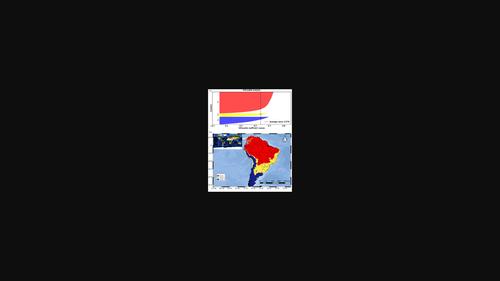当前位置:
X-MOL 学术
›
Int. J. Climatol.
›
论文详情
Our official English website, www.x-mol.net, welcomes your feedback! (Note: you will need to create a separate account there.)
Climatology of heatwaves in South America identified through ERA5 reanalysis data
International Journal of Climatology ( IF 3.9 ) Pub Date : 2022-08-18 , DOI: 10.1002/joc.7831 Glícia Ruth Garcia de Araújo 1 , Ariane Frassoni 1 , Luiz Fernando Sapucci 1 , Daniel Bitencourt 1 , Francisco Agustinho de Brito Neto 1
International Journal of Climatology ( IF 3.9 ) Pub Date : 2022-08-18 , DOI: 10.1002/joc.7831 Glícia Ruth Garcia de Araújo 1 , Ariane Frassoni 1 , Luiz Fernando Sapucci 1 , Daniel Bitencourt 1 , Francisco Agustinho de Brito Neto 1
Affiliation

|
The rise in the Earth's global average surface temperature and the increase of extreme weather events have been the focus of scientific discussion in the last decades. Extreme heat combined with other environmental extremes, like high concentrations of air pollution, may induce health problems—especially in socioeconomically vulnerable populations. Spring in South America requires particular attention due to its association with hot, dry weather and air pollution in most parts of the continent. This paper intends to better comprehend the behaviour of heatwaves during the austral winter–spring transition. We propose identifying the spatial coverage, frequency and intensity of heatwaves in homogeneous areas of maximum air temperature near the surface (Tmax). We employed cluster analyses during the period between July and October for 41 years (1979–2019) through the ERA5 reanalysis. Homogeneous Tmax areas in South America were defined by cluster analyses that indicated three homogeneous Tmax regions, as follows: a larger area of the continent including the tropical region (Area 1), eastern and southeastern South America (Area 2) and southernmost and steep areas in the Andes (Area 3). The heatwave events identified via ERA5 reanalysis were classified according to their intensity (intense, moderate and weak events). Spatial frequency and trend analyses were also performed regarding the intensity and persistence of heatwave episodes. These methods allowed the identification of the behavioural aspect of heatwaves spanning the last four decades. The Mann–Kendall statistical test (MK) was applied in order to analyse the heatwave trend with a statistical significance level of 5%. A total of 191 heatwave episodes were identified. Of this total, 47.12, 35.60 and 17.28% of episodes occurred in Areas 2, 3 and 1, respectively. The hotter area extending from northeast to southwest in central South America stood out by its largest frequencies of intense heatwave episodes. Across the continent there was a significant increase in the intensity and persistence of heatwaves over the period of 1979 through to 2019.
中文翻译:

通过 ERA5 再分析数据确定的南美洲热浪气候学
地球全球平均地表温度的上升和极端天气事件的增加一直是过去几十年科学界讨论的焦点。极端高温与其他极端环境相结合,如高浓度空气污染,可能会引发健康问题——尤其是在社会经济弱势群体中。南美洲的春天需要特别注意,因为它与大陆大部分地区的炎热干燥天气和空气污染有关。本文旨在更好地理解南半球冬春季过渡期间热浪的行为。我们建议确定地表附近最高气温(T max )的均匀区域中热浪的空间覆盖范围、频率和强度). 通过 ERA5 再分析,我们在 7 月至 10 月期间采用了长达 41 年(1979-2019 年)的聚类分析。南美洲的均匀T max区域由聚类分析定义,表明三个均匀的T max区域,具体如下:该大陆的较大区域,包括热带地区(区域 1)、南美洲东部和东南部(区域 2)以及安第斯山脉最南端和陡峭的地区(区域 3)。通过 ERA5 再分析确定的热浪事件根据其强度(强烈、中等和弱事件)进行分类。还对热浪事件的强度和持续时间进行了空间频率和趋势分析。这些方法可以识别过去四个十年热浪的行为方面。应用 Mann-Kendall 统计检验 (MK) 以分析热浪趋势,统计显着性水平为 5%。共确定了 191 次热浪事件。在这一总数中,分别有 47.12%、35.60% 和 17.28% 的事件发生在区域 2、区域 3 和区域 1。南美洲中部从东北向西南延伸的较热地区以其最频繁的强烈热浪事件而脱颖而出。从 1979 年到 2019 年,整个非洲大陆的热浪强度和持续时间显着增加。
更新日期:2022-08-18
中文翻译:

通过 ERA5 再分析数据确定的南美洲热浪气候学
地球全球平均地表温度的上升和极端天气事件的增加一直是过去几十年科学界讨论的焦点。极端高温与其他极端环境相结合,如高浓度空气污染,可能会引发健康问题——尤其是在社会经济弱势群体中。南美洲的春天需要特别注意,因为它与大陆大部分地区的炎热干燥天气和空气污染有关。本文旨在更好地理解南半球冬春季过渡期间热浪的行为。我们建议确定地表附近最高气温(T max )的均匀区域中热浪的空间覆盖范围、频率和强度). 通过 ERA5 再分析,我们在 7 月至 10 月期间采用了长达 41 年(1979-2019 年)的聚类分析。南美洲的均匀T max区域由聚类分析定义,表明三个均匀的T max区域,具体如下:该大陆的较大区域,包括热带地区(区域 1)、南美洲东部和东南部(区域 2)以及安第斯山脉最南端和陡峭的地区(区域 3)。通过 ERA5 再分析确定的热浪事件根据其强度(强烈、中等和弱事件)进行分类。还对热浪事件的强度和持续时间进行了空间频率和趋势分析。这些方法可以识别过去四个十年热浪的行为方面。应用 Mann-Kendall 统计检验 (MK) 以分析热浪趋势,统计显着性水平为 5%。共确定了 191 次热浪事件。在这一总数中,分别有 47.12%、35.60% 和 17.28% 的事件发生在区域 2、区域 3 和区域 1。南美洲中部从东北向西南延伸的较热地区以其最频繁的强烈热浪事件而脱颖而出。从 1979 年到 2019 年,整个非洲大陆的热浪强度和持续时间显着增加。



























 京公网安备 11010802027423号
京公网安备 11010802027423号